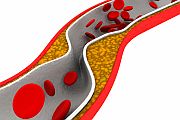- Navigating Your Midlife Crisis: Embracing New Possibilities
- City Raccoons Showing Signs of Domestication
- Mapping the Exposome: Science Broadens Focus to Environmental Disease Triggers
- One Week Less on Social Media Linked to Better Mental Health
- Your Brain Changes in Stages as You Age, Study Finds
- Some Suicide Victims Show No Typical Warning Signs, Study Finds
- ByHeart Formula Faces Lawsuits After Babies Sickened With Botulism
- Switch to Vegan Diet Could Cut Your Greenhouse Gas Emissions in Half
- Regular Bedtime Does Wonders for Blood Pressure
- Dining Alone Could Mean Worse Nutrition for Seniors
New Guidelines Would Greatly Boost Number of Young People on Statins


If all doctors followed new cholesterol guidelines aimed at children, almost half a million Americans aged 17 to 21 would be prescribed a cholesterol-lowering statin drug, a new study predicts.
In 2011, the U.S. National Heart, Lung, and Blood Institute (NHLBI) issued new guidelines on reducing heart disease in adolescents and young adults. Those guidelines recommended that all people aged 17 to 21 get their blood levels of cholesterol checked, and statin treatment be initiated if cholesterol was at a certain level.
In contrast, the American College of Cardiology (ACC) and American Heart Association (AHA) are sticking by adult-focused guidelines that more tightly restrict the use of statins for those under 40 years age.
In the new study, researchers led by Dr. Holly Gooding of Boston Children’s Hospital looked at data from more than 6,300 participants, aged 17 to 21, tracked in federal government health surveys between 1999 and 2012.
Gooding’s team found that 2.5 percent of those with elevated levels of “bad” low-density lipoprotein (LDL) cholesterol would qualify for statin treatment under the NHLBI cholesterol guidelines for children, compared with only 0.4 percent under the ACC/AHA adult guidelines.
That means that 483,500 people in that age group would qualify for statin treatment under the NHLBI guidelines, compared with 78,200 under adult guidelines, the researchers reported.
Compared with those who met the adult guidelines, those who met the children’s guidelines had lower average LDL cholesterol levels, but higher rates of other heart disease risk factors, such as high blood pressure, obesity and smoking.
The study was published online April 6 in the journal JAMA Pediatrics.
It’s common for abnormal cholesterol levels and other heart disease risk factors to start appearing when people are teens, but the two sets of recommendations offer doctors conflicting advice, the researchers said.
For now, they recommend that physicians and patients “engage in shared decision making around the potential benefits, harms, and patient preferences for treatment,” the study authors wrote.
Two heart experts offered differing views on the findings.
Dr. Suzanne Steinbaum is a preventive cardiologist at Lenox Hill Hospital in New York City. She said that, for people aged 17 to 21 with multiple risk factors for heart disease, “medication should be the last resort and a true behavioral and healthy lifestyle program should be implemented.”
Steinbaum added, “Regardless of the guidelines, we need to not have this younger generation rely on medication, but instill in them what healthy food choices, exercise and smoking cessation means before simply giving them a pill. In the short term, it may reduce their cholesterol numbers, but ultimately with obesity and hypertension, their risk of heart disease will continue to escalate.”
Another expert said that the NHLBI guidelines have real merit, however.
The adult-focused guidelines from ACC/AHA “are based solely on randomized controlled trials aimed at lowering events such as heart attacks and strokes,” said Dr. Rubin Cooper, chief of pediatric cardiology at Cohen Children’s Medical Center in New Hyde Park, N.Y.
“These randomized controlled studies were not intended to study the impact of statin therapy in patients ages 17 to 21,” he said. “However, considerable evidence now exists linking the development of atherosclerosis, or hardening of the arteries, to risk factors in childhood and adolescence,” Cooper explained.
“When medication such as statins are ultimately recommended in this age group, they may be continued into young adulthood where adult guidelines are available,” said Cooper, who is also co-director of the hospital’s Pediatric Atherosclerosis Prevention Program.
More information
The American Heart Association has more about cholesterol.
Source: HealthDay
Copyright © 2025 HealthDay. All rights reserved.










